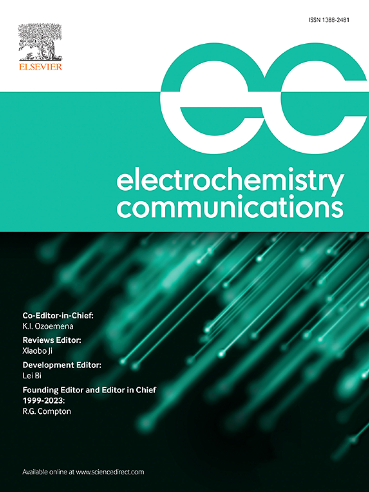缺乏I型铜的铜外排氧化酶直接电子转移型生物电催化双氧还原
IF 4.2
3区 工程技术
Q2 ELECTROCHEMISTRY
引用次数: 0
摘要
铜外排氧化酶(CueO)是一种直接电子转移(DET)型生物电催化剂,用于还原二氧(O2)。在CueO催化循环中,ⅰ型铜(T1Cu)为三核铜中心(TNC)提供电子所必需。然而,T1Cu-deleted (T1D)变体尚未在det型反应中被表征。本研究研究了T1D CueO变体C500S和C500S/E506Q的生物电化学特性。两种变体均表现出通过TNC在Ketjen黑色修饰电极上显著的DET催化电流,而T1Cu似乎加速了CueO的催化循环。此外,C500S/E506Q的活性比C500S高10倍。通过伏安图的动力学分析,估计由于E506Q突变,TNC的重组能降低,导致C500S/E506Q的快速DET。这些发现有助于改善涉及多铜氧化酶的det型反应。本文章由计算机程序翻译,如有差异,请以英文原文为准。
Direct electron transfer-type bioelectrocatalytic dioxygen reduction with copper efflux oxidase lacking type I copper
Copper efflux oxidase (CueO) is a direct electron transfer (DET)-type bioelectrocatalyst used for dioxygen (O2) reduction. Type I copper (T1Cu) has been suggested to be essential for donating electrons to trinuclear copper center (TNC) during the catalytic cycle of CueO. However, T1Cu-deleted (T1D) variants have not yet been characterized in DET-type reactions. This study investigated the bioelectrochemical properties of the T1D CueO variants, C500S and C500S/E506Q. Both variants showed a significant catalytic current representing DET via TNC at the Ketjen black-modified electrode, whereas T1Cu appeared to accelerate the catalytic cycle of CueO. Additionally, C500S/E506Q showed a 10-fold higher activity than C500S. Through kinetic analysis of the voltammograms, the reorganization energy of TNC was estimated to be lowered owing to the E506Q mutation, resulting in fast DET of C500S/E506Q. These findings can help improve the DET-type reactions involving multicopper oxidases.
求助全文
通过发布文献求助,成功后即可免费获取论文全文。
去求助
来源期刊

Electrochemistry Communications
工程技术-电化学
CiteScore
8.50
自引率
3.70%
发文量
160
审稿时长
1.2 months
期刊介绍:
Electrochemistry Communications is an open access journal providing fast dissemination of short communications, full communications and mini reviews covering the whole field of electrochemistry which merit urgent publication. Short communications are limited to a maximum of 20,000 characters (including spaces) while full communications and mini reviews are limited to 25,000 characters (including spaces). Supplementary information is permitted for full communications and mini reviews but not for short communications. We aim to be the fastest journal in electrochemistry for these types of papers.
 求助内容:
求助内容: 应助结果提醒方式:
应助结果提醒方式:


